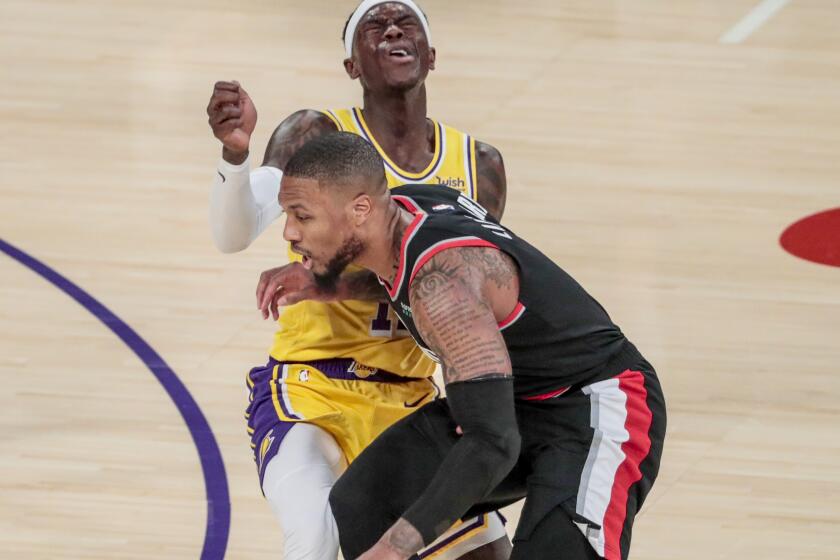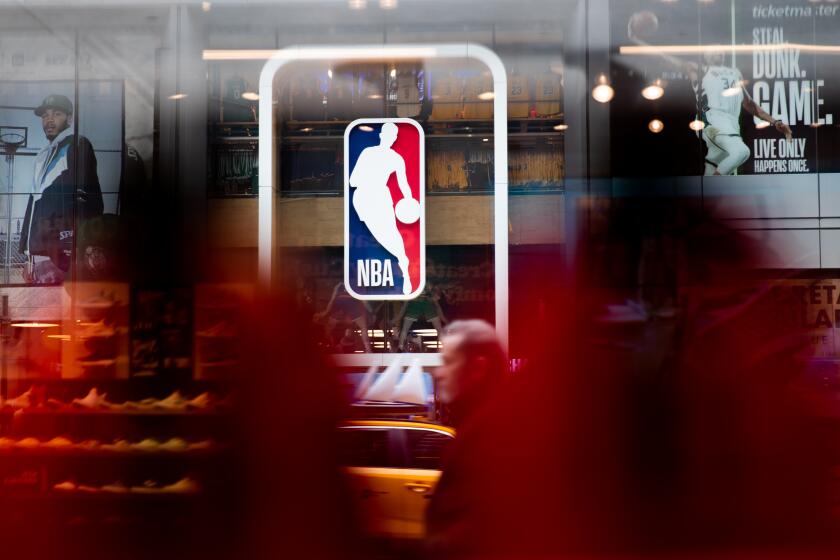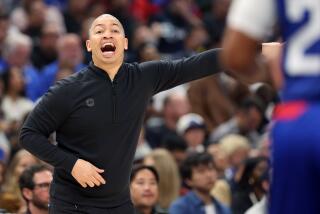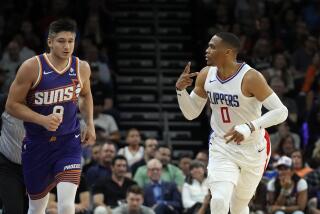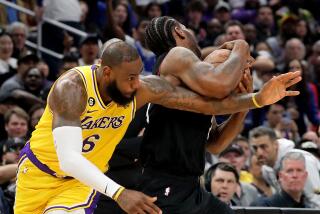NBA 2020-21: A pandemic, injuries and, finally, a second title for Bucks
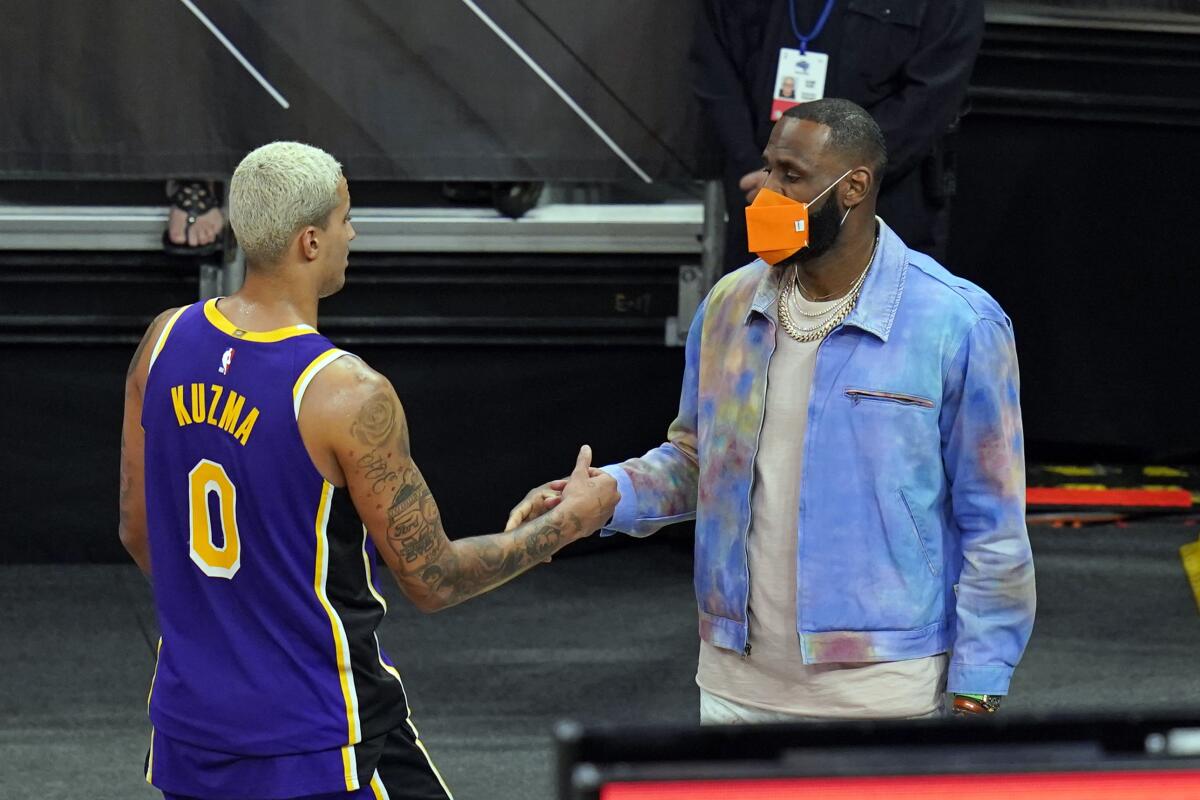
- Share via
When Trae Young placed a finger to his lips in May after his game-winning shot inside New York’s Madison Square Garden temporarily quieted the raucous playoff crowd that had spent several hours cursing and booing the Atlanta guard, the moment took on meaning only a season played amid a pandemic could provide.
Young’s brash call for silence came inside an arena accustomed to it during the season’s first two months: Local COVID-19 restrictions barred fans from attending until the Knicks’ 15th home game. New York was no outlier: Across the league, 440 games this season were played without fans in attendance.
It was why one league executive watching the Hawks-Knicks postseason opener play out against the boisterous backdrop considered it something of a full-circle moment. Finally, a feeling approaching normal.
During the NBA’s 2020-21 season that ended Tuesday with Milwaukee’s Giannis Antetokounmpo raising the Bucks’ first championship trophy in 50 years, such moments could be fleeting, vanishing quicker than De’Aaron Fox on a dead sprint, as the league grappled with the logistics of playing, traveling and living amid a pandemic.
When NBA Commissioner Adam Silver began the trophy ceremony Tuesday, he did so with what sounded like relief in his voice.
“We made it,” he said. “We crowned a champion.”
The injury bug created “what if” scenarios for not only the Clippers and Lakers with Kawhi Leonard and Anthony Davis, but all the top contenders.
Though the NBA crowned its last champion in October on the grounds of Disney World, returning there this season was an option solely of last resort for players and coaches who longed to be near family, and owners and league executives seeking to recoup financial losses by hosting crowds as soon as local health regulations allowed.
The result was a new season dominated by the familiar combination of superstars, pick-and-rolls, trade rumors, three-pointers and the return of cross-country trips. The NBA also had more than 30 postponed games, lineups withered by positive COVID-19 results or contact tracing, and curious moments like the February night when Brooklyn star Kevin Durant was pulled off the court, twice, because he was deemed a close contact. Afterward, he tweeted, “free me.”
Seven Washington Wizards players tested positive during a four-day stretch in January, leading to a nearly two-week pause. At least the Wizards, and 28 other teams, were able to return home. Travel restrictions at the U.S.-Canada border forced the Raptors to trade Toronto for Tampa. Antetokounmpo celebrated his first championship by video chatting with his brother and Bucks teammate, Thanasis — who had missed the two previous games while isolating inside of a hotel because of COVID-related protocols.
There was a reason why Clippers coach Tyronn Lue’s buzzword for his team all season was “adapt.”
In recent years, the league stoked its popularity by keeping two conversations raging simultaneously — analysis of the present together with speculation about the future. In 2021, the future meant considering not only the next big trade or free-agency move but COVID. Coaches, players, executives and agents described learning to live with a feeling of near-constant worry about the next virus-related disruption, waiting for Damocles’ sneaker to drop.
To reach its first NBA Finals appearance since 1993, Phoenix had to endure two games without Chris Paul during the conference finals because the point guard reportedly tested positive for COVID-19. It wasn’t the only high-profile playoff absence. Within weeks of Young’s shush, the Hawks guard hurt himself by stepping on a referee’s foot and reignited a conversation — with the Lakers’ LeBron James among the loudest voices — about how the compressed, 72-game schedule adopted by the league and players’ association might have affected player health, after 10 All-Stars missed at least one playoff game because of injury.
One agent said that multiple players expressed more relief that their daily testing and observation of labyrinthine protocols was finally over when their seasons finished than frustration.
“There were a couple guys that were like, ‘The bubble was easier because you had less choices to make,’” the agent said. He added that players enjoyed the adoption of baseball-style road series and limited interaction with media.
Silver described this season as “an enormous physical and emotional burden on everyone.”
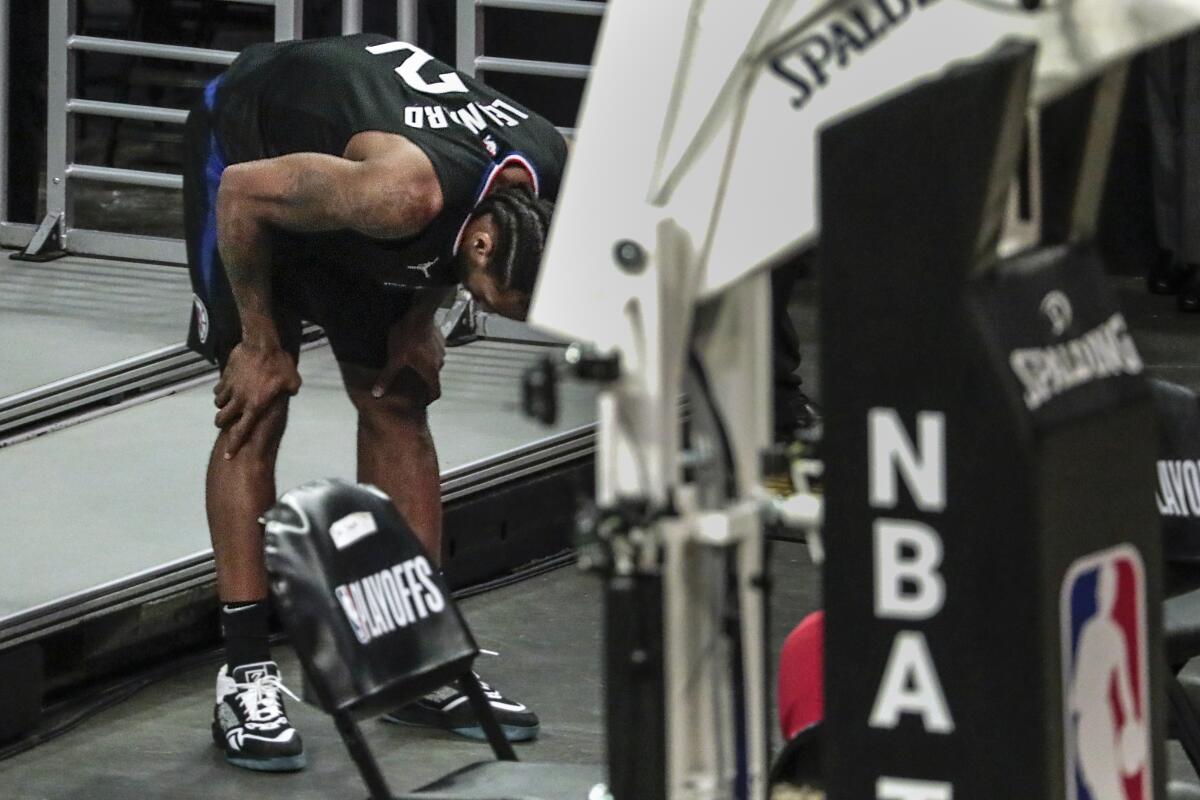
Among the four teams that advanced the deepest in the 2020 playoffs, and were afforded the shortest turnarounds before this season, only one — Denver — advanced out of the 2021 postseason’s first round. Injuries to Anthony Davis and James hobbled the Lakers’ repeat chances after a 71-day offseason, and the Clippers’ championship pursuit was derailed by Kawhi Leonard’s knee injury.
“We were rolling, we had the pieces,” Davis said in June. “We just couldn’t stay healthy.”
Still, this was a season of opportunity. Denver’s Nikola Jokic became a first-time most valuable player. Atlanta’s Young and Dallas’ Luka Doncic led a wave of young stars. Utah center Rudy Gobert earned top defender honors for the third time in four years and Chino Hills’ Ball family produced the top rookie (Charlotte’s LaMelo) and career-best shooting (New Orleans’ Lonzo).
The Clippers began the postseason by losing their first two games at home in front of two-dimensional cutouts of fans. It was the start of an unprecedented, difficult postseason path to the franchise’s first conference finals in five decades, as they became the first team to win consecutive best-of-seven series after falling behind 2-0.
By mid-June, after health and safety regulations lifted across California, a full Staples Center watched as they clinched a second-round victory over Utah. It helped ensure that both No. 1 seeds, the Jazz and Philadelphia, failed to make the conference finals in the same season for only the second time since 1984.
“This is what basketball is all about,” Clippers forward Nicolas Batum said. “It’s 10 guys playing on court with 20,000 people cheering in the stands. That’s why we play basketball, too, to get this connection in this moment, those moments with the fans.”
Some league observers believed the lack of fans would level the playing field and, indeed, home teams’ 54.3% winning percentage during the regular season is the lowest in NBA history. Road teams produced an effective field goal percentage of 49.2% in “clutch” situations, only two percentage points less than home teams, according to a league analysis. By several metrics, there was no better time to be on offense in NBA history.
Across the league, 36.7% of three-point attempts were made to tie the league’s all-time high for accuracy. Teams set all-time-high averages for free-throw accuracy (77.8%) and effective field-goal percentage (53.8%), while tying an all-time low by turning the ball over on only 12.4% of possessions.
Of the 1,080 games played this season, about one in five were decided by 20 or more points. And 59 were decided by 30 or more — one in 20. Compare that to 2018-19, the league’s last full, 82-game season, which produced 56 blowouts by 30-plus points despite staging 150 more games.
A report that Trail Blazers star Damian Lillard will ask for a trade has ignited speculation on where he might land. Can the Lakers acquire him?
One assistant coach said that he and others believed that playing in front of crowds reduced or eliminated by the pandemic had reduced the pressure felt by players, perhaps contributing to the offensive surge, but added that this odd season also dovetailed with an era where shooting has become a most sought-after skill.
“Even poor-shooting players are making corner threes,” the coach said. “It’s certainly a new trend.”
Yet Milwaukee overcame its 32.1% three-point shooting in the postseason — the worst accuracy by a champion in 11 years — to claim a title behind the short-range dominance of Antetokounmpo, who sustained a knee injury late in the previous round yet became just the second player with three 40-point, 10-rebound performances in the Finals.
It came eight months after Antetokounmpo signed a super-max contract to remain with the small-market franchise that drafted him, refusing to follow the path tread by so many other stars toward a larger city.
“This was an amazing journey,” he said afterward, and while he was describing his path from an unknown prospect in Greece, it also applied to this entire season, from its December shotgun start, when many around the league anticipated a mid-January beginning.
Signs of normalcy appear on the horizon. The draft is July 29, free agency begins Aug. 2, followed by summer league’s return to Las Vegas. Next season is scheduled to run on the NBA’s normal calendar, with an October start and June finish.
Key dates for the upcoming 2021-22 NBA season
The league will follow Young’s instruction and fall quiet for a few days, gathering itself before another offseason that is shorter than usual. After more than 65,000 fans who had celebrated Milwaukee’s title in the city’s “Deer District” plaza went home Wednesday morning, Antetokounmpo drove through a Chik-Fil-A drive-through with the championship trophy in his lap and flicked on an Instagram live stream.
Nearly 150,000 viewers tuned in as he ordered a 50-piece nugget meal, the taste of victory earned after a trying season.
More to Read
Go beyond the scoreboard
Get the latest on L.A.'s teams in the daily Sports Report newsletter.
You may occasionally receive promotional content from the Los Angeles Times.


